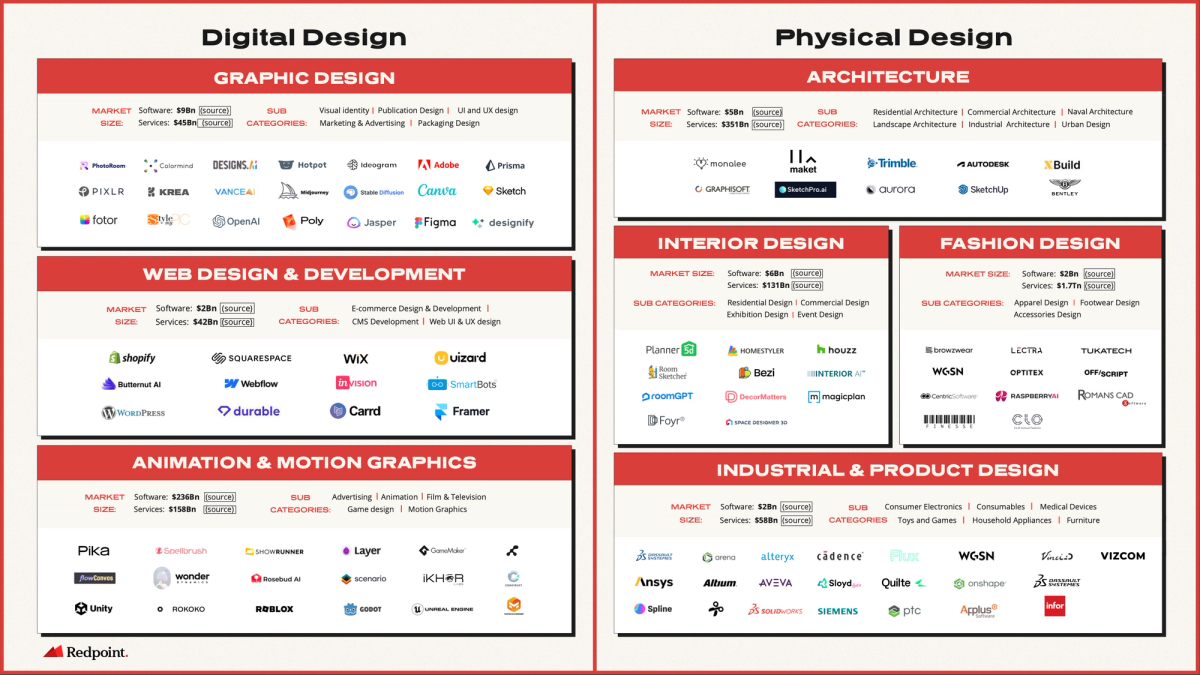If you really knew me, you’d know that I am aesthetically obsessed. And as a student of my surroundings, I’ve been increasingly enamored over the past twelve months by the sizable shifts in how two-dimensional digital designs are being brought to life. With over 90% of web designers leveraging some form of AI to assist with design-related tasks in the last year, the creative workflows of the past are being rapidly reinvented. We believe the greatest change is likely to come in the quarters ahead.
According to Google trends, the search volume for AI design software skyrocketed by 1700% from 2022 to 2023 alone. Generative AI is empowering professional designers to do more, faster, while helping less experienced amateurs accelerate their learning curves. With a simple prompt, AI tools are already enabling us to ideate, create, iterate, and interact in ways few ever imagined. From video game development to architectural design, AI is poised to change the way we imagine, implement, and engage with the aesthetics around us.
To date, much of this progress has been oriented around two dimensional digital design. From the explosion of text to image generators to the proliferation of no-code website creation workflows, the creative world in 2023 was consumed by an impressive emerging collection of AI-enabled solutions. However, while this early cohort of disruptors has already begun to reshape their respective industries, they’ve remained relatively constrained in their reach – with substantial surface area across the design landscape remaining up for grabs. Looking ahead to 2024 and beyond, we see ample opportunities for design software that extends into three dimensional arenas ranging from animation to automotive design – and we couldn’t be more excited to partner with the founders pushing the various frontiers of taste and technology.
Laying the Foundation: Fields of Focus
As AI democratizes design, it’s lowering the barrier to entry for the aesthetically intrigued while simultaneously raising the ceiling of what's possible for professionals. As we first orient around the roles we believe that AI can play in augmenting existing design processes, we find ourselves coming back to six fields of focus:
Inspiration & Ideation.
In the era of AI, designers no longer need to start with a proverbial blank canvas. Given their dexterity in processing extensive amounts of data, AI-enabled tools can efficiently analyze comprehensive design databases, social trends, and personalized preferences to output automated interpretations and recommendations, both expanding the creative range of an initial consideration set and meaningfully compressing the initial research and brainstorming process for a given project. By leveraging the power of AI, designers can delve deep into data, uncover hidden patterns and trends, and gain valuable insights that will inform both product specs and user experiences down the line. While this might look like analyzing social media data to identify trends and predict popularity in the world of fashion design, it could also look like ingesting a homeowner’s prior design decisions to better inform a mood board in the world of interior design. As AI increasingly augments aesthetic intuition in the ideation process, how and where designers spend their time is poised to shift meaningfully – and towards more directly billable domains as AI absorbs more of the pre-planning process.
Generation & Visualization.
As designers go from idea to initial implementation, AI can also dramatically reduce the time and effort required to generate and visualize early prototypes. From automating certain tasks, like creating layouts or selecting color palettes, to enhancing existing designs by solving for suitability or removing rough edges, AI has the potential to more than halve the amount of time designers spend on early generation and visualization efforts. While these models are likely to be far from perfect, at least for the next couple of years, they will significantly expand designers’ top of funnel capacity and corresponding revenue opportunities. While in the world of hardware design this might first be solving for specific geometric constraints, in the world of industrial design this could be refining a project’s initial size and scope. As human-led design generation is increasingly complemented by the power of compute, early visualization efforts are poised to more concretely and efficiently reflect their initial design requirements than ever before.
Co-Creation.
As consumers across categories thirst for identity alignment and aesthetic influence, we’ve seen products, services, and experiences reorient towards a culture of personalization. In the era of AI, this increasingly means customer-led co-creation. As designers and consumers come together to interact with AI through natural language, they’re unlocking an easier way to both relay design preferences and receive recommendations. Younger consumers are more eager than ever to shape the world around them—75% of Gen Z believing generative AI will make them more creative. And as personalization emerges as a standard in next-generation design, businesses are increasingly eager to offer unique and tailored deliverables. Leveraging AI allows them to cut down the time and cost required to bring such degrees of customization to their customers. While this might look like color, fit, and fabric selection in the apparel and footwear industry, it could also look like player-led development of new characters in the multiverse. The opportunities are virtually limitless as imaginations continue to expand the horizon of what’s possible.
Process Automation.
One of the most notable benefits of AI in the realm of design is its capacity to streamline repetitive, rules-based workflows, enabling teams to work at a faster pace and with greater focus on what matters most. As they increasingly embrace virtual automation, designers are freeing up their time to focus on the more innovative, strategic, and differentiated aspects of their projects, both upleveling their individual impact and enhancing their day-to-day experience. This might look like automatic resizing or color-correcting in the world of web design, or automating process updates and reporting in a manufacturing environment. And as these models get smarter, they should be able to be trusted with higher and higher consequence responsibilities.
Simulation.
When it comes to real world products and structures, AI takes the design process one step further by simulating and testing a given design across a set of performance and safety constraints without the need to physically produce it—a time-consuming process that involves the combination of form, style, functionality, and ergonomics. Generative AI simplifies performing these recursive “what if” scenarios and enhances the process of comparing and assessing various product concepts. By creating highly accurate digital models of proposed designs, AI-powered simulation tools enable designers to visualize and test their ideas before they are brought to life, reducing the risk of investing time and resources in an idea that isn’t feasible. In the world of architecture this could look a lot like a digital twin. In medical device design this could look like synthetically testing a product’s performance inside of the human body under various conditions over time. Arguably the greatest opportunity for cost reduction through the end to end design process, enhanced simulation efforts have the potential to afford customers lower overall prices and guarantee designers and the firms employing them a higher overall take rate.
Optimization.
At long last, as designers finally move their digitally-tested visions from the screen to the real world, AI is similarly transforming how designers and the business teams around them approach pricing, production, and procurement decisions. In the world of pricing, these algorithms can analyze input costs, market data, competitor pricing, and design complexity to suggest optimal pricing based on a given company’s priorities (ie: customer reach vs. bottom line margin). Additionally, these platforms can further optimize production processes by better forecasting demand, managing inventory, and streamlining supply chain operations. Finally, in the world of procurement, AI-assisted solutions can recommend vendors based on price, quality, sustainability, and historical supplier performance, ensuring cost-effective and reliable delivery. With downstream delivery and commercialization ultimately serving as the arbiters of any given design’s success, optimization across the three Ps (pricing, production, and procurement) is as top of mind as design development itself for many of the largest organizations.
Opportunities Across Industries:
At Redpoint, we’re actively exploring the categories’ addressable opportunities – and have been amazed by the potential. While the combined market caps of publicly traded design applications sits at north of $500Bn today, we believe that the private markets too hold ample enterprise value potential. Given the size and complexity of the opportunity, we suspect that many emerging leaders leveraging AI will first perfect their products for vertical specific use cases. Thus, in beginning to sketch our initial impressions of the landscape, we elected to categorize companies based on the industries they’re transforming. We recognize that there is considerable category overlap between these players and that extensive addressable design opportunity exists beyond these buckets, but our hope is that this initial attempt is fruitful in laying a foundation to build on top of. Over time, it appears likely that many of the most successful software solutions will extend their reach horizontally into adjacent markets. We’ve seen this time and time again from the biggest and boldest ranging from Autodesk to Adobe, and we’re excited for a new wave of category captains to claim their place over the next few years.

As dreamers across domains envision a world where copilots complement every step of their workflow, there are few areas where we see as much low hanging fruit as the world of design. From facilitating co-creation and elevating aesthetic outputs to driving cost, process, and reliability improvements across production, we’re excited about AI’s potential to transform every phase and industry of design. If you’re as excited about the growing intersection of taste and technology as we are, we’d love to hear from you. Find me on Twitter at @itsmeeraclark or subscribe to my Substack for more.
